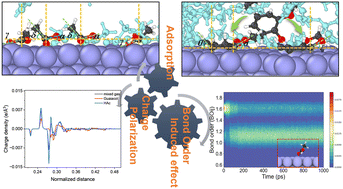Adsorption variations on the Ni(111) surface: electron density diversity from oxygen-containing functional groups†
Abstract
In the catalytic hydrodeoxygenation (HDO) upgrading process of biomass pyrolysis, adsorption behavior plays a crucial role in subsequent reaction processes. A comprehensive understanding of the interfacial behavior is essential for advancing novel biomaterials and commercial bio-oil. We initially establish their precise orientation on the Ni(111) surface and identify the preferential binding site by calculating the binding energy of eight model components (n-butanol, acetic acid, methyl acetate, n-hexanal, toluene, catechol, guaiacol, and 3-methyl-1,2-cyclopentanone). Differences in the electrostatic potential of functional groups and their interactions with the surface lead to surface electrostatic potential distributions, with compounds containing aldehyde functionality demonstrating increased reactivity. To account for competitive adsorption behavior among multiple molecules, ReaxFF-MD simulations were conducted to investigate the adsorption of guaiacol molecules. The inclusion of acetic acid enhances the polarization effect and non-uniformity, indicating competitive adsorption between guaiacol and acetic acid molecules. The chair conformation of acetic acid was demonstrated to be more reasonable from a kinetic perspective, leading to a stronger surface charge induction effect compared to guaiacol. Additionally, this non-uniform distribution is closely correlated with the characteristic bond activations of adsorbed active molecules, serving as a driving force to enhance further hydrogenation and deoxygenation activities of the molecules.

- This article is part of the themed collection: Emerging Investigator Series


 Please wait while we load your content...
Please wait while we load your content...